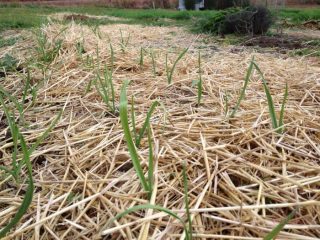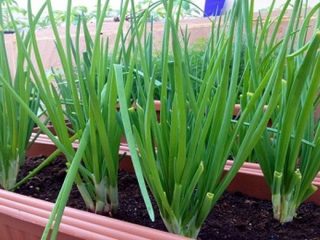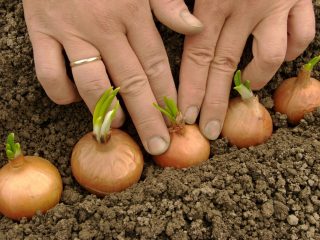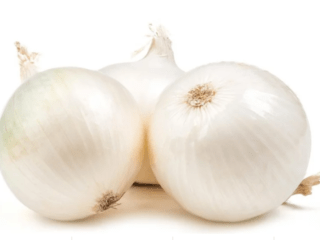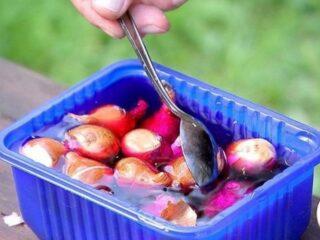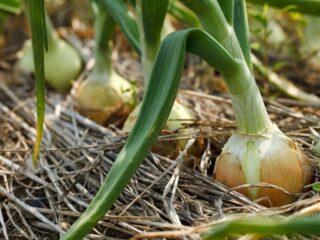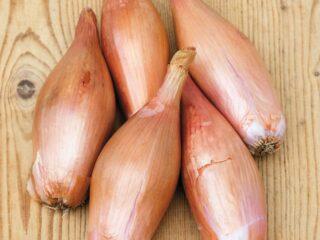Content
Shetana onion is a Czech variety known to Russian gardeners and farmers for more than 20 years. It has tangible advantages - pleasant semi-sharp taste, high yield, disease resistance. The bulbs have a classic round shape, medium size, can be stored for up to one year, and are therefore suitable for sale.
Origin story
Shetana is an onion variety bred by Czech breeders of the MORAVOSEED agricultural company. Included in the Russian register of breeding achievements in 1998. Approved for cultivation in the regions of central Russia (including the Moscow region) and the Volga region.
It is recommended to grow in garden plots on private farms and on an industrial scale. It can be grown as an annual crop (from seeds) or as a biennial crop (planting sets).
However, it is the “Shetan” form that is listed in the official register.It is also used by suppliers of planting material (seeds, onion sets “Shetana MS”).
Description and characteristics of Shetana onion
The variety is characterized by good resistance to temperature changes, short-term frosts and drought. If the minimum cultivation rules are observed, it produces a consistently high yield. The ripening and keeping quality of the crop is very high, which makes it possible to use it for cultivation in personal subsidiary plots and farms.
Appearance
The bulbs have a round shape, medium density, and small weight. If onions are grown from seeds, the average is 45 g, and if from sets - from 65 to 90 g. Dry scales have a straw-yellow color. The necks are of medium thickness. The structure is three-germ.
Ripening time and yield
In terms of ripening time, Shetana onions belong to the mid-early varieties. The harvest is formed on average in 90, maximum 100 days, i.e. already three months after landing. The specific timing of technical maturity (from the moment of emergence) depends on the growing method:
- if you sow seeds, it takes from 88 to 98 days;
- if you sow seedlings - from 64 to 87 days.
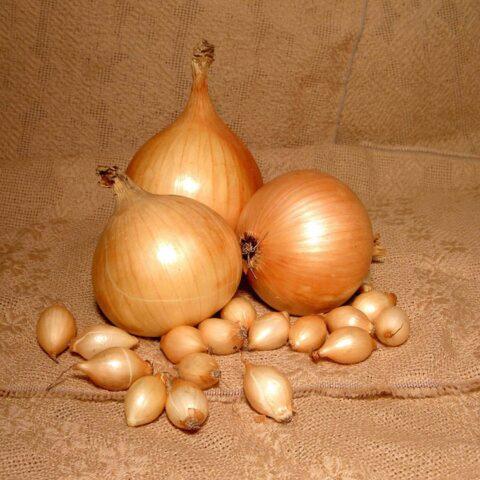
Shetan bulbs ripen in three months
The yield of the crop is high and amounts to about 3–6 kg per square meter (in good years, subject to agricultural practices - up to 8 kg). When grown on an industrial scale, the figure reaches 260–290 c/ha, which corresponds to the standards of the Carmen MS and Tatarsky varieties.
The highest yield of the variety was 435 c/ha. This is 160 quintals more than the same figure for the Carmen MS variety. The record was recorded when grown from sets (as a biennial crop) in the climatic conditions of the Moscow region.
Resistance to diseases and pests
Onions of the Shetana variety are resistant to fusarium, but may suffer from downy mildew (downy mildew). Damage from onion flies, moths, thrips and other pests is possible. Therefore, it is recommended to carry out preventive treatments and periodically monitor plantings in order to prevent the development of diseases in the early stages.
Composition and properties
The composition of Shetan onion includes water (88%) and dry substances (12%), including the following components:
- sugar – up to 6.3%;
- ascorbic acid – 7.2 mg per 100 g;
- vitamins of group B, PP, E;
- glycosides;
- phytoncides;
- flavonoids;
- pectins;
- macro- and microelements (potassium, iron, phosphorus, sulfur and others).
The taste of Shetan onion is semi-sharp and quite pleasant. The pulp is juicy, medium density, pure white.
Where is it used?
Due to its semi-sharp taste, Shetana onions can be used fresh, such as in salads and appetizers. It is suitable for first and second courses, as well as for all kinds of preparations (salting, marinating).
In cool, moderately humid conditions, the crop can be stored for a very long time - up to 9-12 months.
Advantages and disadvantages
Shetan's bow has many advantages, which are objectively greater than the disadvantages. The crop is undemanding to weather conditions and tolerates short-term frosts and drought. The yield is high, the taste is pleasant, and the shelf life is very long.Thanks to this, the Shetana variety managed to gain popularity among both summer residents and farmers.
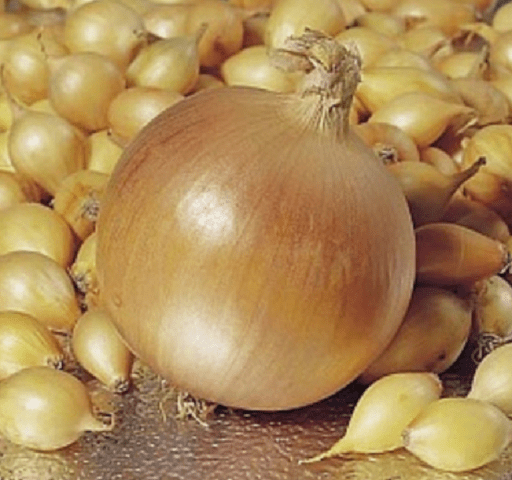
Shetana is characterized by high yield and attractive presentation
Pros:
- good taste;
- bulbs aligned;
- keeping quality;
- transportability;
- excellent ripening (up to 100%);
- resistance to fusarium;
- the arrow gives practically no effect.
Minuses:
- no resistance to downy mildew;
- may suffer from onion flies and other pests.
Methods for planting Shetana onions
This variety can be grown in different ways. Turnips and greens (an annual crop) are obtained from the seeds. You can also take feathers or heads from the sets (biennial crop).
Growing from seeds
Shetana onion seed material can be immediately planted in open ground. It is necessary to wait until the soil warms up to at least 8–10 degrees. Therefore, the timing depends on the characteristics of a particular region:
- middle zone - early May;
- south – second half of April;
- areas with cool spring – the third ten days of May.
The Shetana variety is quite demanding on the location - it must be well-lit and dry (without stagnant moisture), if possible protected from strong winds. The optimal soil type is loam or sandstone with a slightly acidic or neutral reaction (pH from 6.0 to 7.0).
1–1.5 months before planting the Shetana onion, the area is cleaned, dug up and a bucket of compost or humus is added per 1–2 m2. And if the soil is clayey, add an additional 1 kg of sawdust or sand for the same area. The best predecessors are representatives of legumes and nightshades, and the worst are garlic, asparagus and cucumbers of any variety.
Before planting, the seeds should be prepared by soaking them in different liquids:
- 30 minutes in a 2% solution of potassium permanganate;
- 6–8 hours in warm water;
- after drying for about 8 hours in a solution of Epin, Zircon or another stimulant;
- then in damp gauze for a week at room temperature (let it sit in a saucer).
Technology for planting prepared onion seeds of the Shetana variety:
- Level the surface of the bed.
- Mark several furrows (depth 2 cm, distance 10 cm).
- Plant the seeds at 10 cm intervals.
- Cover lightly with soil and give a little water.
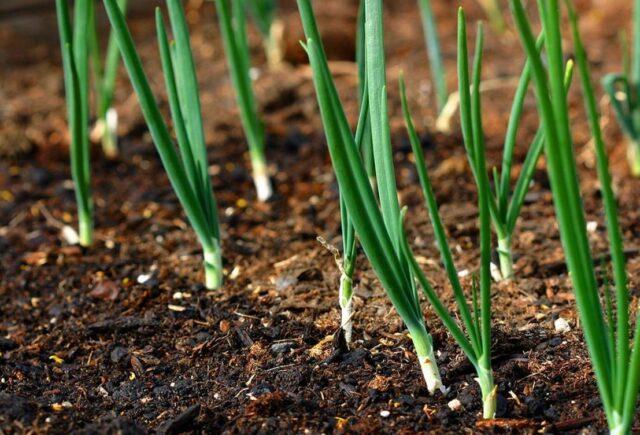
When planting, leave a distance of 10 cm between seeds.
Planting seedlings in open ground in spring
Shetana onion sets are planted at the same time as the seeds. He also needs preliminary preparation. Only high-quality seed without damage or stains is selected and heated for 7 hours at a temperature of 40–45 degrees. Planting is carried out in holes to a depth of 2 cm, the interval between furrows is 40–50 cm. The sequence of actions is exactly the same as when sowing seeds.
Planting Shetan onions before winter
The variety is a winter crop, so the seedlings can be planted in the fall. In this case, the onion will be more productive. The preliminary preparation of planting material is exactly the same, however, you will additionally need to sort the bulbs by size:
- small and medium-sized up to 1–3 cm in diameter - for turnips;
- large ones from 3 cm in diameter - for early greens.
Sowing Shetan onions before winter is planned 3-4 weeks before the onset of the first frost. In the middle zone this is the beginning of October, in the south - the end of the month, and in regions with cold autumn - the end of September. The planting technology is similar, but in addition a fairly high layer of mulch is poured. Shetana onions can be protected with straw, sawdust, hay, peat and other natural materials.
Shetana onion care
The variety is undemanding to growing conditions, although to obtain a good harvest it is necessary to provide regular watering at least once every seven days. Three weeks before harvesting, they stop giving water, even if there is a drought.
Loosening and weeding are carried out regularly, especially after rain or watering. Fertilizers are applied three times per season. In all cases, you can use complex fertilizing (30–40 g per 1 m2) or alternate it with organic matter (litter 1:20, mullein 1:10).
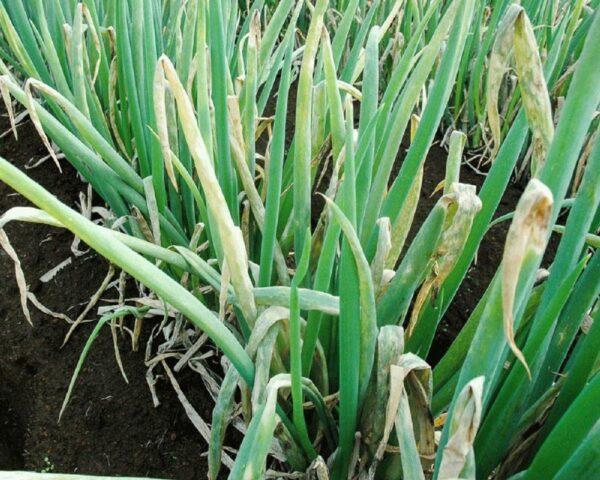
To prevent downy mildew in the spring, plantings are treated with Bordeaux mixture or another fungicide.
Conclusion
Shetana onion is one of the few foreign varieties that has taken root well in central Russia and neighboring regions. Resistant to adverse weather conditions and some pests. Gives a consistently high yield if the rules of agricultural technology (watering and fertilizing) are observed.
